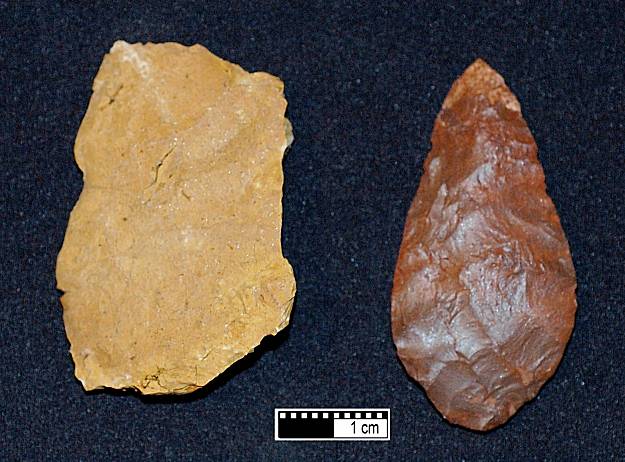
Those Stone Age people became the world's first engineers - they discovered that the intense heat of a fire's embers could make chunks of stone much easier to flake for making tools, and to make them much sharper too.
It was "a breakthrough adaptation in human evolution," reports an international group of archaeologists and anthropologists. And it may have come about because of changes in those early human's brains, other scientists say.
What began at least 165,000 years ago became the most common method of stone toolmaking in Africa by about 72,000 years ago.
The scientists from Africa, Australia and Arizona analyzed nearly 200 ancient tools found around cave dwellings at a South African coastal site called Pinnacle Point, which earlier excavations had shown were inhabited by people of the Middle Stone Age.
The knives, scrapers and hand axes were made of a widely used type of silicate rock called silcrete. Some of the scientists, reporting in the current issue of the journal Science, are themselves skilled at "knapping" - the art of chipping stones by hand to create sharp tools - and their tools demonstrated the clear improvements possible from heat treatment at fire temperatures of 450 Fahrenheit or more.
Others explored the South African sites where they collected ancient silcrete tools that were deliberately heat-treated by the Stone Age people. They analyzed them with high-tech methods to reject any that may have accidentally fallen into hearth fires or been heated later in accidental bush blazes.
"Early modern humans regularly employed pyrotechnology to increase the quality and efficiency of their stone tool manufacturing process," wrote team leader Kyle Brown of South Africa's University of Cape Town and the Institute of Human Origins at Arizona State University in Tempe.
That ability to "alter and improve available raw materials and the quality and efficiency of stone tool manufacture may have been a behavioral advantage" over others, including the Neanderthals, Brown and his colleagues wrote.
At UC Berkeley, anthropologist Steven Shackley noted that in California and elsewhere in the American Southwest, the people of the well-known Clovis culture who had migrated from Siberia across the Bering land bridge some 13,000 years ago also used fire to temper their stone tools - apparently their own age-old technology.
"So for those earlier Stone Age people of 100,000 years ago, this report suggests that something was going on in their brains and something was changing the forms of their hands to make that improvement in stone tools possible," Shackley said.
Katherine Pollard, a biostatistician and human genome analyst at the Gladstone Institutes in San Francisco, supported Shackley's conjecture that changes in brain DNA may have endowed those Stone Age folks with new toolmaking skills.
"It seems almost certain that there were some genetic changes involved," she said in an e-mail. "These may have affected our ancestors' brains, but could also have been involved in manual dexterity or vision or other systems.
"It will probably be a while before we can link specific genetic changes to specific neurological changes and then to events in the archaeological record. We just don't really know that much yet about how our brains work. But, it will be cool to see how these stories unfold."



Reader Comments
to our Newsletter